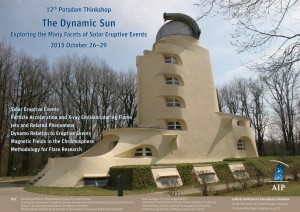Small-scale Chromospheric Jets above a Sunspot Light Bridge
Rohan Eugene Louis (Leibniz-Institut für Astrophysik Potsdam (AIP))
Abstract. High-resolution broadband filtergrams of active region NOAA 11271 in Ca ii H and G band were obtained with the Solar Optical Telescope on board Hinode to identify the physical driver responsible for the dynamic and small-scale chromospheric jets above a sunspot light bridge. We identified the jets in the Ca images using a semi-automatic routine. The chromospheric jets consist of a bright, triangular-shaped blob that lies on the light bridge, while the apex of this blob extends into a spike-like structure that is bright against the dark umbral background. Most of the jets have apparent lengths of less than 1000 km and about 30% of them have lengths between 1000-1600 km. They are oriented within +/-35 deg. to the normal of the light bridge axis. Many of them are clustered near the central part within a 2 arcsec area. The jets are seen to move rapidly along the light bridge and most of them cannot be identified in successive images taken with a 2 min cadence. The jets are primarily located on one side of the light bridge and are directed into the umbral core. The Stokes profiles at or close to the location of the blobs on the LB exhibit both a significant net circular polarization and multiple components, including opposite-polarity lobes. The magnetic field diverges from the light bridge towards the umbral cores that it separates. In the photosphere there is a predominantly uni-directional flow with speeds of 100-150 m/s along the light bridge which is interrupted by a patch of weak motions that also moves along the light bridge. The dynamic short-lived jets above the LB seem to be guided by the magnetic field lines. Reconnection events are a likely trigger for such phenomenon since they occur at locations where the magnetic field changes orientation sharply. We find no clear relation between the jets and the photospheric flow pattern.
Contributed Talk

Write a comment Close comment form